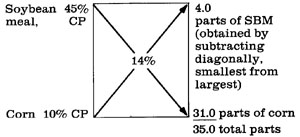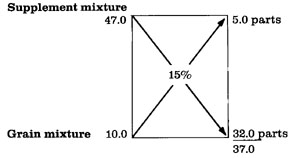by J. Wagner and T.L. Stanton* (6/12)
Quick Facts…
- The Pearson square ration formulation procedure is designed for simple rations.
- In order for the square to work, follow specific directions for its use.
- Nutrient contents of ingredients and nutrient requirements must be expressed on the same basis (i.e., dry-matter or “as-fed”).
The Pearson square or box method of balancing rations is a simple procedure that has been used for many years. It is of greatest value when only two ingredients are to be mixed. In taking a close look at the square, several numbers are in and around the square. Probably one of the more important numbers is the number that appears in the middle of the square. This number represents the nutritional requirement of an animal for a specific nutrient. It may be crude protein or TDN, amino acids, minerals or vitamins.
 |
In order to make the square work consistently, there are three very important considerations:
- The value in the middle of the square must be intermediate between the two values that are used on the left side of the square. For example, the 14 percent crude protein requirement has to be intermediate between the soybean meal that has 45 percent crude protein or the corn that has 10 percent crude protein. If barley is used that has 12 percent crude protein and corn that has 10 percent crude protein, the square calculation method will not work because the 14 percent is outside the range of the values on the left side of the square.
- Disregard any negative numbers that are generated on the right side of the square. Be concerned only with the numerical differences between the nutrient requirement and the ingredient nutrient values.
- Subtract the nutrient value from the nutritional requirement on the diagonal and arrive at a numerical value entitled parts. By summing those parts and dividing by the total, you can determine the percent of the ration that each ingredient should represent in order to provide a specific nutrient level. Always subtract on the diagonal within the square in order to determine parts. Always double check calculations to make sure that you did not have a mathematical error. It also is very important to work on a uniform basis. Use a 100-percent dry-matter basis for nutrient composition of ingredients and requirements and then convert to an as-fed basis after the formulation is calculated.
Corn represents (31.0 / 35.00) x 100 of the ration, or 88.57 percent. Soybean meal represents (4.0 / 35.00) x 100 of the ration, or 11.43 percent. Check of the calculation:
| 88.57 lb corn x 10.0% CP | = | 8.86 |
| 11.43 lb SBM x 45.0% CP | = | 5.14 |
| 100.00 lb mixture contains | = | 14.00 lb CP, or 14 percent. |
 |
Using More Than Two Ingredients
It is possible to mix more than two ingredients using the Pearson square. For example, to prepare a 15 percent crude protein mixture that consists of a supplement of 60 percent soybean meal (45 percent crude protein) and 40 percent corn gluten meal (45 percent crude protein), and a grain mixture of 65 percent corn (9 percent crude protein) and 35 percent oats
(12 percent crude protein), take the following steps.
Since only two components can be used in the Pearson square method, the ingredients are combined first as follows:
| 60% SBM x 45% crude protein | = | 27.0 |
| 40% CGM x 45% | = | 18.0 |
| Protein in supplement mixture | 45.0% | |
| 65% corn x 9.0% | = | 5.85 |
| 35% oats x 12.0% | = | 4.20 |
| Protein in grain mix | 10.05% | |
| 5.0 parts x 60% | = | 3.0 parts SBM |
| 5.0 parts x 40% | = | 2.0 parts CGM |
| 30.0 parts x 65% | = | 19.5 parts corn |
| 30.0 parts x 35% | = | 10.5 parts oats |
| 35.0 | ||
| (3.0 / 35.0) | = | 8.57% SBM |
| (2.0 / 35.0) | = | 5.71% CGM |
| (19.5 / 35.0) | = | 55.72% corn |
| (10.5 / 35.0) | = | 30.00% oats |
| Check: | ||
| 8.57 lb SBM at 45% CP | = | 3.86 lb |
| 5.71 lb CGM at 45% CP | = | 2.57 lb |
| 55.72 lb corn at 9% CP | = | 5.01 lb |
| 30.00 lb oats at 12% CP | = | 3.60 lb |
| 100.00 lb contains | 15.04 lb or 15% CP | |
Expressing Feed Composition
The crude-protein value of a feed or the percentage of any other component (e.g., calcium or phosphorus) can be expressed several ways. The two most common methods of expression are on an as-fed basis or dry-matter basis. Use the following procedure to calculate composition on a dry-matter basis.
Crude protein value on an as-fed basis divided by dry-matter content of the feed times 100 equals the crude-protein content on a dry-matter basis. If alfalfa hay is used as an example, the crude protein value is 17 percent on an as-fed basis. On a dry-matter basis, the crude protein value of the hay is calculated as follows: 17 / 0.91 (moisture content of 9 percent) times 100 equals 18.7 percent crude protein.
To determine the total digestible nutrient (TDN) content of the above alfalfa on a dry-matter basis, follow the same procedure: 50 percent (TDN value on an as-fed basis) divided by 0.91 (dry-matter content of the feed) times 100 equals 54.9 percent TDN on a dry-matter basis. Likewise, the crude-protein content or the TDN value also can be expressed on the basis of any given dry-matter level. For example, if you use a 90-percent dry-matter basis, use the following calculation. Given a TDN value of 76 percent and a dry-matter content of 86 percent (14 percent moisture), what would be the TDN value of this feed on a 90 percent dry-matter basis?
(76 x .90) / .86 = 79.5 percent TDN on a 90 percent dry-matter basis.
Ration Composition Calculations
If you know the dry-matter composition of a specific ration and want to determine what that composition will be on an as-fed basis for mixing, make the calculations shown in Table 1.
Conversely, if you know the “as-fed” composition of the ration and the dry matter of each ingredient, determine the ration dry-matter composition as shown in Table 2.
| Table 1: Converting from dry matter to as-fed. | |||||
| Feed | Ration dry-matter composition |
Ingredient % dry matter |
Calculations | Ration as-fed composition |
|
|---|---|---|---|---|---|
| Corn silage | 70 | 35 | 70/.35 = 200 | (200/233) x 100 = | 84.84 |
| Alfalfa | 30 | 90 | 30/.90 = 33 233 |
(33/233) x 100 = | 14.16 |
| Table 2: Converting from as-fed to dry matter. | |||||
| Feed | Ration dry-matter composition |
Ingredient % dry matter |
Calculations | Ration as-fed composition |
|
|---|---|---|---|---|---|
| Corn silage | 65 | 35 | 65 x .35 = 22.75 | (22.75/54.25) x 100 = | 41.94 |
| Alfalfa | 35 | 90 | 35 x .90 = 31.50 54.25 |
(31.50/54.25) x 100 = | 58.06 |
1 J. Wagner, Colorado State University professor, animal sciences and general manager, Southeastern Colorado Research Center; T. Stanton, former Extension feedlot specialist and professor, animal sciences. 9/93. Revised 6/12.
Colorado State University, U.S. Department of Agriculture and Colorado counties cooperating. Extension programs are available to all without discrimination. No endorsement of products mentioned is intended nor is criticism implied of products not mentioned.
Go to top of this page.





